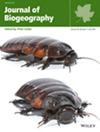Taxonomic, Functional and Phylogenetic Beta Diversity of Upland Forest Birds in the Amazon: The Relative Importance of Biogeographic Regions, Climate and Geographic Distance
Abstract
Aim
We address the relative importance of biogeographic regions (areas of endemism), regional climate and spatial factors on taxonomic, functional and phylogenetic beta diversity of bird assemblages in upland terra-firme forests in the Amazon.
Location
Amazon biome.
Taxon
Birds.
Methods
We gathered 27,498 occurrence records of 873 bird species for 115 bird assemblages distributed in all nine biogeographic regions delimited by the major Amazonian rivers. Only data from studies surveying whole communities with standard sampling methods and exhaustive sampling effort were included. We partitioned the fractions of taxonomic, functional and phylogenetic beta diversity explained by climate, biogeographic regions, spatial factors and the variation shared between them.
Results
Across the entire Amazon, we found higher total taxonomic (0.68 ± 0.10) than phylogenetic (0.46 ± 0.08) β-diversity, and low functional β-diversity (0.34 ± 0.08). Biogeographic regions showed the highest unique contributions explaining taxonomic and phylogenetic β-total (7% and 5%, respectively) and turnover components (7% of β-jtu taxonomic, 7% of β-jtu phylogenetic), but accounted for only 2% of total functional β-diversity and trait turnover. Climatic variables explained slightly more trait nestedness (5%) compared with species and lineage turnover (3% each). Species composition was clearly distinct between biogeographical regions limited by the Amazon River, but support for the effect of other rivers was mixed.
Main Conclusions
Our study highlights the significant influence of biogeographic regions and climate on species composition in the Amazon. However, our findings also suggest that the Amazon River exerts a more pronounced impact on species distribution compared with other major Amazonian rivers. Species turnover across biogeographical regions is particularly evident at the species level, with minor effects observed in functional traits, suggesting that taxonomic turnover is driven mainly by functionally redundant species. In addition, recent diversification events, occurring predominantly at the tips of the phylogeny without substantial turnover at deeper nodes, are likely responsible for the patchy distribution of species across Amazonia.

 求助内容:
求助内容: 应助结果提醒方式:
应助结果提醒方式:


